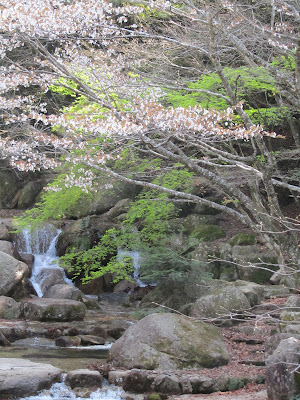My last excursion was to Hiroshima. Since I was tight on time, I left the train station, hopped on a trolley, and headed straight to the Peace Park. This building is the Atomic Bomb Dome. It has looked like this since the day the bomb was dropped on August 6th, 1945. It has been reinforced so it continues to stand as a reminder of the horrific bombing.
Here is the plaque with the inscription.
This is what the dome looked like before the bombing.
The town really is beautiful and modern. I wished that I would have had some more time to explore.
I headed across the park to the children's memorial. Here, there were millions of paper cranes folded in the name of peace.
From far away, you just get a rush of color, but close up you can see each individual crane representing the pain and the hope together.
Here is the statue that actually represents the children who were harmed and killed in the bombing.
A closer look at the memorial. If only world peace were this easy.
There were many glass display cases filled with origami cranes, many with designs like these.
As I walked toward the museum at the end of the peace park, I finally understood the memorial. I was looking through a dome, to the flame of peace and onto the A-dome. It was at this point in my stroll that the memorial finally made sense and I got the big picture.
Upon entering the museum, I was surprised to find this clock that counted down since the last nuclear test. I was even more surprised to find that the world's last nuclear test was performed by the US in November. Funny, that I am a US citizen and I didn't even know about it. And, funny that we are demanding all these trade regulations for other nations based on their desire to nuclear test, but yet we are doing it and not answering to anyone. Just interesting.
Here is a watch that belonged to a person living here in Hiroshima during the time of the bomb. It stopped at the exact time the bomb hit, 8:15 am.
This is a replica of a letter from Albert Einstein telling the US of the potential of nuclear weapons and the need to stop the development of such weapons.
This is a mural of the city after the bomb destroyed most of Hiroshima.
These are paper cranes actually made by Sadako. Even before I was a teacher, I loved her story. If you would like to know more, please read the book Sadako and the Thousand Paper Cranes by Yamaguchi Shoten. I loved the exhibit in the museum dedicated solely to her.
I was a little apprehensive to enter the museum, as I heard it was biased against the US. Honestly, after spending the majority of an afternoon there, I found quite the opposite. The museum accurately displayed all the things that happened during the war, including all the invasions and battles initiated by the Japanese. I did find that it was an emotional day. I left feeling tired, not sad, but more aware. I did feel disappointed that the US doesn't always seems forthright with its actions, especially involving nuclear testing. After contemplating, reflecting, and mourning for those lost in war, I walked back through this beautiful park thankful to be alive and confident that I will never make such a decision.

























































